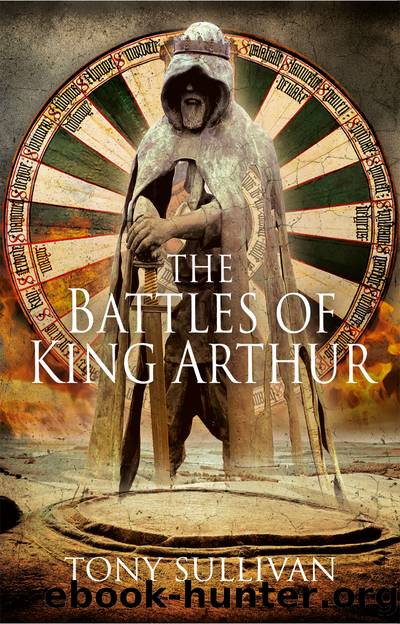The Battles of King Arthur by Tony Sullivan;

Author:Tony Sullivan;
Language: eng
Format: epub
Tags: HISTORY / Europe / Great Britain / General
Publisher: Casemate Publishers & Book Distributors, LLC
Published: 2022-07-30T00:00:00+00:00
Map 21: Origins of Armorica
The Irish and Picts
Some of the proposed battle locations are far in the north and suggest Arthur may have been fighting Picts as well as Angles. This would come as no surprise given the well-documented raids from both the Picts and Irish. We recall that Gildas claimed the Picts captured the north âup to the wallâ and the later appeal to Aetius was in response to Pictish raids. So, too, was Vortigernâs hiring of Saxon mercenaries. Geoffrey of Monmouth has Arthur fighting as far north as Moray and, as well as defeating Pictish armies, he fights an Irish army just as his father Uther is said to have done a generation before.
The first historical record of the Picts occurs at the end of the third century.158 They spoke a Brittonic language and lived in small, scattered, rural communities. Tacitus, writing in the first century, describes their ancestors as having âreddish hair and large limbsâ. Describing the campaign of Agricola in AD 83, he calls the land north of the River Tay, âCaledoniaâ, but the people are Britanni or Britons. We get an interesting account of the Battle of Mons Graupius. The Caledonians mustered a large force with over 30,000 men under many kings, one of whom was named Calgacus. The front rank was on level ground with the rest lined up on the slope behind. Chariots manoeuvred on the flat ground in front. The Romans lined up six cohorts of Germanic auxiliaries in the centre with cavalry on the flanks. The rest of the legion was held in reserve. Tacitus, no doubt embellishing the scene, states the battle started with a rain of spears from both sides. Then the Roman war-hardened auxiliaries in the centre attacked, pushing the Caledonians backwards up the hill, striking them with the âbosses of their shields and stabbing them in the face.â159 We can compare this to later tactics where the sword was used more as a cutting weapon and the edge of the shield would be more effective than the boss. The cavalry easily dispersed the chariots and then outflanked the enemy and attacked the rear. Many broke and fled, while others conducted small counter-attacks throughout the day until Tacitus tells us âour soldiers were tired of killing.â He estimates 10,000 Caledonians lay dead with Roman losses below 400.
Agricola returned south but the fleet continued north around Scotland and down the western side of Britain. The information they gathered later assisted Ptolemy, a second-century Greek geographer, in constructing a map. It shows sixteen tribes occupying Scotland, twelve north of the Forth-Clyde isthmus. Roman rule was consolidated south of the Solway-Tyne after briefly extending to the Antonine Wall between the Forth and the Clyde in central Scotland. However, within a generation, the Romans abandoned that wall and retreated back to Hadrianâs Wall running between Carlisle and Newcastle.
In the late second century, Cassius Dio records Hadrianâs Wall being overrun. Two main tribes, possibly confederations, were to blame: the Caledonians and the Maeatae, the latter being from the Stirlingshire area.
Download
This site does not store any files on its server. We only index and link to content provided by other sites. Please contact the content providers to delete copyright contents if any and email us, we'll remove relevant links or contents immediately.
The Radium Girls by Kate Moore(11621)
100 Deadly Skills by Clint Emerson(4691)
The Templars by Dan Jones(4558)
Rise and Kill First by Ronen Bergman(4545)
The Doomsday Machine by Daniel Ellsberg(4246)
The Rape of Nanking by Iris Chang(4023)
Killing England by Bill O'Reilly(3897)
Hitler in Los Angeles by Steven J. Ross(3798)
Stalin by Stephen Kotkin(3724)
12 Strong by Doug Stanton(3419)
Hitler's Monsters by Eric Kurlander(3164)
Blood and Sand by Alex Von Tunzelmann(3055)
Darkest Hour by Anthony McCarten(3018)
The Code Book by Simon Singh(2857)
The Art of War Visualized by Jessica Hagy(2839)
Hitler's Flying Saucers: A Guide to German Flying Discs of the Second World War by Stevens Henry(2624)
Babylon's Ark by Lawrence Anthony(2431)
The Second World Wars by Victor Davis Hanson(2421)
Tobruk by Peter Fitzsimons(2374)
